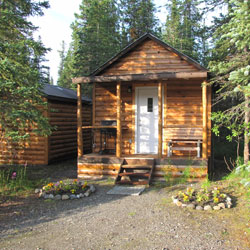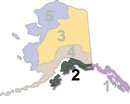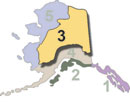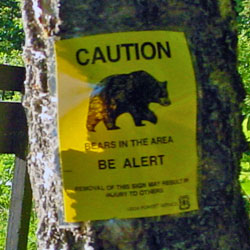Camping
For some, camping means driving a motorhome to a paved campground, backing into a level parking area, hooking up the water and power, and relaxing on lawn chairs around a steel fire ring while pre-split spruce quarters give off a cheery glow. For others, it means hiking many miles over a rough trail to a high mountain lake where the only shelter is a tent and your meals are the fish you caught or whatever you carried in on your back. Either way, Alaska offers endless opportunities.

The Gear
If you're staying in a campground, you can get by with an inexpensive tent, sleeping bags, pads, and perhaps a camp stove. If the tent leaks or the stove won't stay lit you can always drive to town. But if you're camping in a remote area, that may not be an option. Therefore it is in your best interest to take take a closer look at the features and quality of your gear. Check out our Gear Pages for details on everything you need.
Recreational Cabins, Shelters & Tent Platforms
The state of Alaska is dotted with hundreds (if not thousands) of public and private recreational cabins. Some of these were built by homesteaders many years ago, but they passed into state or federal hands when the owner moved on. They are now maintained by the appropriate agency for public use. Most cabins offer basic amenities such as plywood bunks (without bedding), a wood or oil-fired stove, table and chairs, and in some cases, a boat to use. Shelters are also available. These are usually a three-sided structure with a roof and are designed to mostly keep you protected from rain and snow. They are very rustic but can be a welcome break. Finally, tent platforms may also be available. A tent platform is basically a wooden deck with tiedown points to secure your tent. Steep terrain, combined with thick vegetation makes it impossible to find a clear, level spot on which to pitch a tent, and that's where a tent platform is ideal. Though some campers will roll the dice in hopes of finding a structure unoccupied, in most cases cabins must be reserved well in advance of your trip. Never put your entire trip on the line, expecting to find the cabin unoccupied!
For complete listings of recreational cabins, shelters, and tent platforms around the state, check out our Cabins pages.
Tent Camping
Alaska offers endless possibilities for tent camping on public lands, whether you prefer the amenities and access of a public campground or the freedom of pitching your tent where you like in a remote location. But before you go, be advised that Alaska has private lands where trespass is forbidden. In many cases, the land is not fenced or posted, but you can still be cited for trespassing. Some landowners offer fee-based trespass rights; check in advance to ensure you don't end up on someone else's property. The single best place to verify landholders is the Bureau of Land Management's Public Lands Information Office.
Let's have a look at the differences in camping opportunities around the state.
Region 1: Southeast Alaska
Summer campers in Region 1 should come expecting rain. If you're geared for it, it's actually quite pleasant. The sound of raindrops on the cabin roof, or even on your tent's rainfly is a soothing lullaby while you relax in your warm, dry shelter.
Panhandle Cabins and Shelters
The comfort and security of a sturdy cabin add tremendously to one's enjoyment of the wilderness. There are close to 200 public-use cabins and shelters located in the Tongass National Forest and surrounding areas throughout Region 1. Most of them offer nearby opportunities for fishing, hunting, and hiking. Some are situated near coastal areas, and others are located on lakes in the interior of some of the larger islands. Some cabins even include a boat and oars. Finally, some cabins also include a shed where hunters can care for game meat, work on hides, and the like. If you are hunting out of a recreational cabin, please carry your bones and meat scraps some distance away from the cabin to dispose of them. Otherwise, you are forming an attractant for bears to come to the cabin, and you could unintentionally cause problems for subsequent users.
For a complete list of cabins and shelters in the Tongass, including reservation information, rental fees, amenities, and much more, CLICK HERE.
Panhandle Campgrounds
There are a number of campgrounds in Region 1, which offer RV or tent camping. Here is a list of locations:
Chilkoot Lake State Recreation Site
Mosquito Lake State Recreational Site
Portage Cove State Recreation Site
Wilderness Tent Camping
The Panhandle offers superb wilderness camping opportunities, however, vegetation in some areas is really thick. If you're camping in old-growth forested areas, avoid camping too close to large trees; dead limbs can break off and land on your tent! Choose a clearing instead.
Region 2: North Gulf Coast, Kenai Peninsula, and the Kodiak / Afognak Archipelago
Region 2 offers excellent camping opportunities of all types. There are dozens of recreational cabins (public and private), road-based campgrounds (tents, campers, and RVs), and many wilderness camping opportunities.
Cabins and Shelters
The Chugach National Forest covers the entire North Gulf Coast area, and it contains 40 public cabins that are available by reservation with the Forest Service's office AT THIS LINK. Some of the cabins are along the coast, with beautiful views and great fishing opportunities nearby. Most are remote and are accessed either by floatplane or boat. Some are on the road system. Skater's Cabin, just outside Cordova, is also available.
The Kenai Peninsula offers many public and private cabins. Contact the Chugach National Forest, the Kenai National Wildlife Refuge, or check our Directory for cabins available for rent.
The Kodiak / Afognak island group offers remote wilderness cabins as well. Check with the Kodiak National Wildlife Refuge for cabins on Kodiak Island, and with Afognak Island State Park for cabins on Afognak.
Campgrounds
There are a number of campgrounds in Region 2, which offer RV or tent camping. Here is a list of locations:
Cordova Area
Kenai Peninsula
Wilderness Tent Camping
Region 2 offers excellent remote camping opportunities. The Prince William Sound area offers superb beach camping that can be accessed by boat or by floatplane. In most cases you'll have the entire beach to yourself, with activities like beachcombing, clamming, hiking, hunting, and fishing all right from the doorway of your tent. Refer to Paul Twardock's "Kayaking and Camping in Prince William Sound" for specific locations. Another must-have for boating in the Sound is Jim and Nancy Lethcoe's landmark book, "The Cruising Guide to Prince William Sound". It contains tons of information on safe anchorages for your boat and shore-based camping areas.
The Kenai Peninsula offers both fly-in and hike-in camping in many areas. Check out the Johnson Pass Trail, Resurrection Pass Trail, and others. These trails offer access to remote fishing and hunting opportunities as well. CHECK THIS LINK for a partial listing.
Region 3: Interior and Eastern Arctic
The Eastern Arctic offers excellent remote camping opportunities, and some road-based camping as well, though the road system here is limited. The Interior offers much more road-based opportunities, but some remote camping here as well. Most of the folks camping off the road in this area are either fishing or hunting on a fly-out basis.
Cabins and Shelters
The White Mountains National Recreation Area is about an hour north of Fairbanks, and contains several public-use cabins that are available year-round. CLICK HERE for reservations.
Chena River State Recreation Area. This area is located 26 miles east of Fairbanks in the upper Chena River valley. There are ten cabins available at various locations throughout the recreation area.
The Birch Lake State Recreation Area has one cabin available, Birch Lake Cabin, which houses up to six people in a 16x20 cabin. The cabin has a wood stove, and you have to bring your own wood. Other amenities include a fire ring, picnic table, and a table with seats.
Salcha River State Recreation Area. The Salcha River Cabin measures 14x20 and can house three people. It includes a fire ring (bring your own wood), a picnic table, a wood stove, and a table with seats.
Big Delta State Historical Park contains the Ferryman's Cabin, a 12x14 structure that houses four people. It includes an electric heater, table, seats, and has electric power.
Delta State Recreation Site, at MP 267 of the Richardson Highway, has the Delta Cabin, a 16x20 structure that houses four people. It includes a wood stove (bring your own wood), a fire ring, picnic table, table, and seats.
Donnelly Creek State Recreation Site, on the Delta River at MP 238 of the Richardson Highway, has the Donnelly Creek Cabin. It's 16x20 and houses four people. It includes a woodstove (bring your own wood), a fire ring, a picnic table, a table, and seats.
Quartz Lake State Recreation Area, in the Delta Junction area, offers two cabins. The Quartz Lake Cabin is 20x24 and can house six people. It includes a woodstove (bring your own wood), a fire ring, picnic table, and an interior table with benches. This cabin is frequently in use during the summer months by park volunteers, so check ahead. The Glatfelder Cabin is an older, rustic cabin located a half-mile from the campground. It's 20x24 and accommodates six people. It includes a wood stove (bring your own wood), a fire ring, picnic table, table, and seats.
Fieldling Lake State Recreation Site has one cabin, the Fielding Lake Cabin. It's a 12x14 structure that can house up to six people. It has a wood stove (bring your own wood), a fire ring, picnic table, interior table, and seats.
Campgrounds
Lower Chatanika State Recreation Area
Birch Lake State Recreation Area
Big Delta State Historical Park. Located on the Tanana River eight miles north of Delta Junction (MP 274.5), this area includes 23 large pull-through sites, 21 campsites, 2 picnic sites, an RV dump station, and two outhouses.
Delta State Recreation Site. Located at MP 267 of the Richardson Highway, and contains 25 campsites, a covered picnic area, water, and toilet facilities.
Donnelly Creek State Recreation Site is on the Delta River at MP 238 of the Richardson Highway. It includes 12 campsites, toilets, and water.
Quartz Lake State Recreation Area includes 16 proper campsites and a parking lot area where you can camp as well. There's a fishing dock, picnic sites, a picnic shelter, water, and toilets. This is a very popular area for fishing in Quartz lake, so be prepared for large crowds.
Wilderness Tent Camping
Region 4: Southcentral, Bristol Bay, the Alaska Peninsula, and the Aleutians
Region 4 is a study in extremes. On one hand, it contains Anchorage, which houses half the population of the state. It, therefore, has the most extensive road system in the state and the greatest number of roadside camping opportunities. On the other hand, it also contains lower-key road-based camping to the east along the Copper River. Farther west of Anchorage is a roadless wilderness for hundreds of miles. With the exception of a handful of isolated communities, the entire area is wilderness. Most folks heading into this area are on multi-day wilderness expeditions for hiking, wildlife viewing, hunting, or fishing.
Cabins and Shelters
Campgrounds
Wilderness Tent Camping
Region 5: Western Arctic and the Yukon-Kuskokwim Delta
With the exception of a handful of smaller villages, this area is remote wilderness; some of the most remote Alaska has to offer. Public campgrounds are nonexistent, but remote camping opportunities abound. Be extra-careful to bring along a solid, four-season mountaineering tent and other equipment appropriate for remote wilderness expeditions, because when that airplane drops you off and buzzes off over the horizon, you're on your own.
Cabins and Shelters
Campgrounds
Wilderness Tent Camping
Be Bear-Aware!
Alaska is bear country! Anglers must be aware of the possibility of encountering bears along any salmon stream. Revillagigedo Island has a robust black bear population and due to heavy vegetation in many areas, encounters can happen at close range. In recent years there have been reports of brown bears on the eastern side of the island. Take the following precautions:
- Make plenty of noise while hiking or fishing.
- Don’t give bears a reason to associate people with food! Keep food and your catch in a backpack on your back.
- Protect yourself! Bring a firearm or pepper spray to use as a deterrent.
